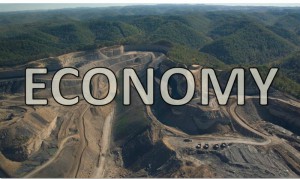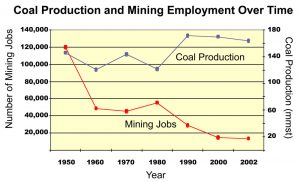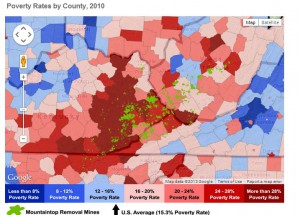Part 2 in a 5 part series
LIE 2: ECONOMY

Lie 2 of 5: Economy. Calling mountaintop removal an economic driver couldn’t be further from the truth.
Proponents of mountaintop removal mining use a very simple and straightforward logic to justify the practice: jobs are good for the economy, and mountaintop removal mining provides jobs, therefore mountaintop removal mining is good for the economy.
The argument is logical, but only if you ignore the actual, well-established and thoroughly understood impacts that mountaintop removal has had throughout the region.
Mountaintop removal equals job removal. Coal companies are always looking for ways to cut costs and make their workers more efficient. In other words, they want to get more coal while using fewer miners. That’s where surface mining comes in. Underground mining in Appalachia requires approximately 50 percent more miners than surface mining to acquire the same amount of coal.
By blowing up mountains, using massive draglines, and dumping the resulting waste into streams and valleys, companies can avoid the increase in costs per ton of coal. That may be good news for coal operators, but it’s bad news for miners.
Over the past half century, coal companies have been successful in increasing production while getting rid of those pesky costs (read: coal miners).
The late Senator Robert Byrd (D-WV) understood this as well as anyone. Shortly before he passed away Byrd told his colleagues in congress:
“The increased use of mountaintop removal mining means that fewer miners are needed to meet company production goals. Meanwhile the Central Appalachian coal seams that remain to be mined are becoming thinner and more costly to mine. Mountaintop removal mining, a declining national demand for energy, rising mining costs and erratic spot market prices all add up to fewer jobs in the coal fields.”
It’s important to note that the amount of coal mined in Appalachia is dictated by market demand. If Alpha Natural Resources can sell 10 million tons of coal for a profit, they will mine 10 million tons of coal. If they have to hire more miners to get the job done, they will hire those miners. And if getting the job done requires a traditional underground mine instead of a mountaintop removal mine, they will bite the bullet and mine the coal underground.

The relationship between mining employment and coal production reveals when surface mining became prevalent in Appalachia.
For more than a century, coal mining has served as an economic base in Appalachia, and it has helped shaped the cultural identity the region. After peaking in the 1940s, coal mining employment in Appalachia fell off a cliff, gigantic machines moved in and surface coal mining has maligned the Appalachian landscape and economy ever since.
The Bush administration made it easy for companies to dump mining waste into valleys and streams, and since then, massive mountaintop removal mines have become commonplace, but the destruction of the Appalachian mountains and the streams throughout them has been going on for a long time. At every step, coal companies and their advocates have touted the economic benefits and job creation that they assured us would result from more mining.
This leaves one major question. To quote Sen. Mitch McConnell (R-KY), “where are the jobs?”
Mountaintop removal coal mining is not an economic driver. It’s a dirty way for coal companies to turn a profit without regard for the health and well being of Appalachian communities.
Industry advocates also claim that reclaimed mine sites provide much needed flat land to develop the Appalachian economy. We will discuss the problems with that particular lie on Monday.
LIE 1: BALANCE
> > LIE 2: ECONOMY
LIE 3: ELECTIONS




I have really been looking forward to this blog series, but could you provide citations to some of this info (besides the quotes)? Where are you finding these graphics? I would love to be able to point some of my friends and family to some studies and sites for some hard evidence. I’ve got some very deluded family members who live near or work on MTR sites that are spoon fed a lot of the crap you are addressing.
I look forward to the next post!
Many thanks,
one concerned and currently displaced West Virginian
So glad you’re interested, Displaced WV-ian. We created each of these graphics using publicly available data. The poverty rate map can be found here (https://ilovemountains.org/the-human-cost) and it is based on info from the U.S. Census Bureau (https://www.census.gov/did/www/saipe/data/statecounty/data/2010.html).
For coal productivity by region, state, year, and mining method, check out OpenSourceCoal.org where we’ve crunched data from several federal agencies into a more user friendly format.
Thank you for the resources, and thank you for doing this blog series. I am an ardent believer that if people, especially in WV, know the facts, see it with their own eyes, and try to think beyond the immediate (as well as understand the history of our region), and realize how much spin goes into ‘selling’ MTR, hearts and minds could be changed. I am a proud West Virginian, and I hate to see my beloved mountains and my people sacrificed on the altar of the almighty dollar.
Thank you!
one concerned and currently displaced West Virginian